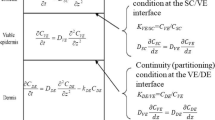Abstract
The finite element method is employed to simulate two-dimensional (axisymmetric) drug diffusion from a finite drug reservoir into the skin. The numerical formulation is based on a general mathematical model for multicomponent nonlinear diffusion that takes into account the coupling effects between the different components. The presence of several diffusing components is crucial, as many transdermal drug delivery formulations contain one or more permeation enhancers in addition to the drug. The coupling between the drug and permeation enhancer(s) results in nonlinear diffusion with concentration-dependent diffusivities of the various components. The framework is suitable for modeling both linear and nonlinear, single- and multicomponent diffusions, however, as it reduces to the correct formulation simply by setting the relevant parameters to zero. In addition, we show that partitioning of the penetrants from the reservoir into the skin can be treated in a straightforward manner in this framework using the mixed method. Partitioning at interface boundaries poses some difficulty with the standard finite element method as it creates a discontinuity in the concentration variable at the interface. To our knowledge, nonlinear (concentration-dependent) partitioning in diffusion problems has not been treated numerically before, and we demonstrate that nonlinear partitioning may have an important role in the effect of permeation enhancers. The mixed method that we adopt includes the flux at the interface explicitly in the formulation, allowing the modeling of concentration-dependent partitioning of the permeants between the reservoir and the skin as well as constant (linear) partitioning. The result is a versatile finite element framework suitable for modeling both linear and nonlinear diffusions in heterogeneous media where the diffusivities and partition coefficients may vary in each subregion.
Similar content being viewed by others
References
Alonso, A., N. C. Meirelles, and M. Tabak. Effect of hydration upon the fluidity of intercellular membranes of stratum corneum: An EPR study. Biochim. Biophy. Acta 1237:6–15, 1995.
Barry, B. W. Penetration enhancers. Pharmacol. Skin 1:121–137, 1987.
Chandrasekaran, S. K., A. S. Michaels, P. S. Campbell, and J. E. Shaw. Scopolamine permeation through human skin in vitro. AIChE J. 22:828–832, 1976.
Collier, S. W., and R. L. Bronaugh. Receptor fluids. In: In Vitro Percutaneous Absorption: Principles, Fundamentals and Applications, edited by R. L. Bronaugh, and H. I. Maibach. Boca Raton, FL: CRC Press, 1991, pp. 31–49.
Crank, J. The Mathematics of Diffusion, 2nd ed. Oxford: Oxford University Press, 1975, pp. 38–39.
Forslind, B. The skin: Upholder of physiological homeostasis. A physiological and (bio)physical study program. Thrombosis Res. 80:1–22, 1995.
Gummer, C. L., and H. I. Maibach. Diffusion cell design. In: In Vitro Percutaneous Absorption: Principles, Fundamentals and Applications, edited by R. L. Bronaugh, and H. I. Maibach. Boca Raton, FL: CRC Press, 1991, pp. 8–16.
Guy, R. H., and J. Hadgraft. Physicochemical interpretation of the pharmacokinetics of percutaneous-absorption. J. Pharm. Biopharm. 11:189–203, 1983.
Guy, R. H., and J. Hadgraft. Transdermal drug delivery: A simplified pharmacokinetic approach. Int. J. Pharm. 24:267–274, 1985.
Hadgraft, J. Passive enhancement strategies in topical and transdermal drug delivery. Int. J. Pharm. 184:1–6, 1999.
Hughes, T. J. R. The Finite Element Method: Linear Static and Dynamic Finite Element Analysis. New York: Dover, 2000, pp. 195–196.
Huth, S., R. Neubert, L. Boltze, and A. Büge. Experimental determination and mathematical modelling of propylene glycol transport from semisolid vehicles. Chem. Pharm. Bull. 44:1263–1266, 1996.
Kalia, Y. N., and R. H. Guy. Modeling transdermal drug release. Adv. Drug Deliv. Rev. 48:159–172, 2001.
Kubota, K., and E. H. Twizell. A nonlinear numerical model of percutaneous drug absorption. Math. Biosci. 108:157–178, 1992.
Lee, A. J., J. R. King, and T. G. Rogers. A multiple-pathway model for the diffusion of drugs in skin. IMA J. Math. Appl. Med. Biol. 13:127–150, 1996.
Lee, A. J., J. R. King, and S. Hibbard. Mathematical modeling of the release of drugs from porous, nonswelling drug-delivery devices. IMA J. Math. Appl. Med. Biol. 15:135–163, 1998.
Manitz, R., W. Lucht, K. Strehmel, R. Weiner, and R. Neubert. On mathematical modeling of dermal and transdermal drug delivery. J. Pharm. Sci. 87:873–879, 1998.
Missel, P. J. Finite element modeling of diffusion and partitioning in biological systems: The infinite composite medium problem. Ann. Biomed. Eng. 28:1307–1317, 2000.
Moser, K., K. Kriwet, A. Naik, Y. N. Kalia, and R. H. Guy. Passive skin permeation enhancement and its quantification in vitro. Eur. J. Pharm. Biopharm. 52:103–112, 2001.
Padmanabhan, R., B. Gale, B. Phipps, W. van Osdol, and W. Young. D-TRANS technology. In: Modified-release Drug Delivery Technology, edited by M. Rathbone, J. Hadgraft, and M. Roberts. New York: Marcel Dekker, 2003, pp. 481– 498.
Phipps, B., M. Cormier, B. Gale, W. van Osdol, J. Audett, R. Padmanabhan, and P. Daddona. Transdermal drug delivery. In: Encyclopedia of Biomaterials and Biomedical Engineering, edited by G. Wnek. New York: Marcel Dekker, 2004, pp. 1677–1689.
Potts, R. O., and M. L. Francoeur. The influence of stratum corneum morphology on water permeability. J. Invest. Dermatol. 96:495–499, 1991.
Roy, S. D., and G. L. Flynn. Transdermal delivery of narcotic analgesics: pH, anatomical, and subject influences on cutaneous permeability of fentanyl and sufentanil. Pharm. Res. 7:842–847, 1990.
Schueckler, F., and G. Lee. Relating the concentration-dependent action of azone and dodecyl-L-pyroglutamate on the structure of excised human stratum corneum to changes in drug diffusivity, partition coefficient and flux. Int. J. Pharm. 80:81–89, 1992.
Skelly, J. P., V. P. Shah, H. I. Maibach, R. H. Guy, R. H. Wester, G. L. Glynn, and A. Yacobi. FDA and AAPS report of workshop on principles and practices of in vitro percutaneous penetration studies: Relevance to bioavailability and bioequivalence. Pharm. Res. 4:265–267, 1987.
Zienkiewicz, O. C., and R. L. Taylor. The Finite Element Method, 4th ed., Vol. 1, Singapore: McGraw-Hill, 1989, pp. 373–376.
Author information
Authors and Affiliations
Corresponding author
Rights and permissions
About this article
Cite this article
Rim, J.E., Pinsky, P.M. & van Osdol, W.W. Finite Element Modeling of Coupled Diffusion with Partitioning in Transdermal Drug Delivery. Ann Biomed Eng 33, 1422–1438 (2005). https://doi.org/10.1007/s10439-005-5788-6
Received:
Accepted:
Issue Date:
DOI: https://doi.org/10.1007/s10439-005-5788-6




